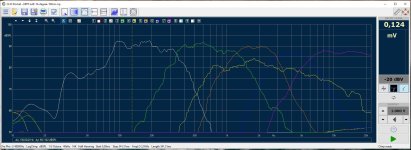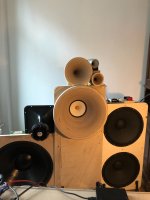That first room was a demo room at a forum users hifi show.
My home room is smaller.
I guess that's why the Synergy horns work so well.
They sound together even from closer up.
Big horn systems need lots of space to integrate. Also room reflections are more of a problem with very rounded horn mouths they send the waves everywhere.
The 50° conical works great in a longer narrower room.
For wider shorter rooms a 90° dispersion would be ideal.
I'm building 60° versions now to try.
DIY till you die🙂
My home room is smaller.
I guess that's why the Synergy horns work so well.
They sound together even from closer up.
Big horn systems need lots of space to integrate. Also room reflections are more of a problem with very rounded horn mouths they send the waves everywhere.
The 50° conical works great in a longer narrower room.
For wider shorter rooms a 90° dispersion would be ideal.
I'm building 60° versions now to try.
DIY till you die🙂
Hi all, posted some time ago this proof of concept exercise for a multi horn system with short listening distances
CLIO measurements without 21 inch OB sub woofers
10 degree Right CH / Left CH equalized for unsymmetrical
listening position 150 cm L / 350 cm R at my home office desk


got it to work for near field listening position only after the introduction of miniDSP 8 Flex DL Dirac room correction
https://www.diyaudio.com/community/threads/ultimate-open-baffle-gallery.123512/post-7669194
decent left channel right channel photos by daylight


decent left channel right channel photos by daylight
CLIO measurements without 21 inch OB sub woofers
10 degree Right CH / Left CH equalized for unsymmetrical
listening position 150 cm L / 350 cm R at my home office desk


got it to work for near field listening position only after the introduction of miniDSP 8 Flex DL Dirac room correction
Attachments
Really? My understanding is that the high directivity (beamy) dispersion pattern of horns like the JMLC AH425 is too sharply focused to develop much room reflections-at least a relatively small number of early reflections, compared to other (e.g. constant directivity?) horns.Also room reflections are more of a problem with very rounded horn mouths they send the waves everywhere.
And comparatively, this (exponential) horn https://josephcrowe.com/blogs/news/es-450-biradial-no-2143 would probably have the next least early reflections, as evidenced by its also narrowing directivity.
https://cdn.shopify.com/s/files/1/0...ot_2023-10-14_170306_480x480.png?v=1697317415
Presumably, horns like the ES450 are intended to strike a balance between the better imaging ability of high directivity horns and the spaciousness of lower directivity (CD) horns. And I keep wondering if that's why I see a lot of AH425 horns for sale.
Last edited:
"Beamy" generally refers to a pattern that narrows at high frequenciesMy understanding is that the high directivity (beamy) dispersion pattern of horns like the JMLC AH425 is too sharply focused to develop much room reflections-at least a relatively small number of early reflections, compared to other (e.g. constant directivity?) horns.
There are (large..) constant directivity horns have more narrow patterns at 500Hz than the AH425 has at 10kHz.
The AH425 directivity pattern ranges from over 120 degrees (low DI) to ~30 degrees (high DI) over its usable range, so its room reflections will vary with frequency.
The 450 biradial is a bit wider overall than the AH425, but more narrow in it's vertical dispersion.And comparatively, this (exponential) horn https://josephcrowe.com/blogs/news/es-450-biradial-no-2143 would probably have the next least early reflections, as evidenced by its also narrowing directivity.
You could choose a constant directivity horn with directivity around the average of beamy horns like the ES450 or AH425.Presumably, horns like the ES450 are intended to strike a balance between the better imaging ability of high directivity horns and the spaciousness of lower directivity (CD) horns.
Or not.
You can find far more used low DI "constant directivity" horns on the used market than AH425 horns.And I keep wondering if that's why I see a lot of AH425 horns for sale.
Individual preferences change over time.
It seems counterproductive for a CD horn to have directivity patterns that narrow. What kind of room would benefit from that?"Beamy" generally refers to a pattern that narrows at high frequencies
There are (large..) constant directivity horns have more narrow patterns at 500Hz than the AH425 has at 10kHz. The AH425 directivity pattern ranges from over 120 degrees (low DI) to ~30 degrees (high DI) over its usable range, so its room reflections will vary with frequency.
My biggest problems with the AH425 is that 1) I have and will not have any chance to hear it any time soon enough before I need to, and 2) after Gary and Pierre's experiences with the AH425/Radian745Be combo I refuse to risk becoming another dissatisfied user. Gary's > 7 years with AH425/Yamaha JA6681B is perhaps the safest choice given Gary's professional background. https://www.bremertonwestsoundsymphony.org/gary-dahl-bio
Otherwise, it looks like the ES450/DCM50 16 ohm/Fostex T925A is the other option.
Last edited:
It seems counterproductive for a CD horn to have directivity patterns that narrow. What kind of room would benefit from that?
Do a search for short and long throw horns. Think large venue or Pro. A cd horn family example: Short throw typically used at home and monitors.
Rob 🙂
https://www.lansingheritage.org/html/jbl/specs/pro-comp/2360-series.htm
For completeness, I would add that the Reddit member who loves his AH425/Radian950Be combo uses this...after Gary and Pierre's experiences with the AH425/Radian745Be combo
https://www.diyclassd.com/products/fusion-amplifiers/fusionamp-fa503 So, perhaps the larger diaphragms and/or the more precise DSP filtering is what made it all work well for him. As I prefer to stay with my own amplifiers and DAC and passive or (maybe later) active analog crossovers, a different Radian Be /horn combo is needed.
Rooms don't benefit from radiation patterns, listeners do.It seems counterproductive for a CD horn to have directivity patterns that narrow. What kind of room would benefit from that?
Narrow horn patterns increase the direct to reflected ratio of sound, which allows listeners to hear more of the original signal as it was received by the microphone or instrument pickup (recorded or live), and less of the room they are listening in.
Gary Dahl's extensive musical background and career as a musician, orchestra conductor, and music teacher is impressive.Gary's > 7 years with AH425/Yamaha JA6681B is perhaps the safest choice given Gary's professional background. https://www.bremertonwestsoundsymphony.org/gary-dahl-bio
In my career as sound engineer working with musicians, conductors, and music teachers I have found their ability to hear musical details I can't, while not noticing sonic details quite apparent to me quite informative in their instrument and sound equipment choices.
Or perhaps the specific radiation pattern of the AH425 and his particular choice of speaker placement, toe in and listening position was also what made it work for him, as illustrated in this post:For completeness, I would add that the Reddit member who loves his AH425/Radian950Be combo uses this
https://www.diyclassd.com/products/fusion-amplifiers/fusionamp-fa503 So, perhaps the larger diaphragms and/or the more precise DSP filtering is what made it all work well for him.
Yes, a horn with a higher directivity index has a higher direct to reflected ratio than a lower DI horn.As for the direct/reflected sound ratio, if the (single) listener is positioned close to that apex then would not he get more direct sound from a higher directivity horn, like the AH425, and more reflected sound from a lower directivity horn, like the B&C M90 or NicoB's horns?
In post # 434, I responded both to Camplo's post 431, and your post 432 quoting a Reddit poster.
Reflections from a high...Incredibly 3D it sometimes sounds like it’s coming from behind you. Surreal.
At any rate, different drivers or filtering won't change a horn's radiation pattern or the room it's in, or help your decision making process which primarily seems based on other people's preferences.
Art
But while specific driver/horn combos will also impact this, has is it by now been generally established which horn geometries are less prone to creating HOMs than others? For example, horns like these, which have no fins?EQ can't really fix reflections, diffraction, HOM's etc.
https://josephcrowe.com/products/3d-cad-model-for-horn-no-1689-800hz-es-circular-horn
https://josephcrowe.com/products/3d-cad-files-horn-no-1994-es450-biradial-for-jbl-2446-2-throat
And "Throat bump to eliminate small resonance near the cutoff frequency (600Hz)" in these horns? https://josephcrowe.com/products/es-600-bi-radial-wood-horn-no-1978
- Home
- Loudspeakers
- Multi-Way
- Best Compression Drivers today 2022?

